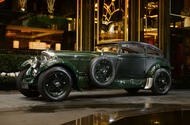What’s the story behind the Bentley Blue Train Special?
If you’ve ever wondered why the Bentley Blue Train Special holds such an outsized place in automotive lore, you’re not alone. The story is a blend of daring, luxury, and a bit of British cheek. Back in 1930, Woolf Barnato—Bentley’s owner, a double Le Mans winner, and heir to a diamond fortune—made a wager that would become legendary. Sitting in the bar of the Hotel Carlton in Cannes, he bet £100 that he could beat the famed Blue Train, a luxury express ferrying England’s elite from the Riviera to Calais, back to London. Not just by minutes, but by a margin that would make headlines.
Barnato and his friend Dale Bourne set off in a Bentley Speed Six just before 6pm, braving rain, fog, a burst tire, and the logistical nightmare of finding fuel in rural France. Against the odds, they parked outside London’s Conservative Club four minutes before the Blue Train even reached Calais. The result? Pure magic. Barnato pocketed his winnings but paid a heavier price in fines from irate French officials, who also barred Bentley from exhibiting at the Paris Salon that year. Yet, the legend of the Blue Train Bentley was born, cementing both car and driver in the annals of motoring history.
Which car really raced the Blue Train—and why does it matter?
For decades, the car believed to have made the run was the stunning Gurney Nutting-bodied Speed Six Sportsman’s Coupé. Its sweeping lines and imposing presence seemed to fit the story perfectly. But recent research by its owners, Bruce and Jolene McCaw, revealed a twist: Barnato actually drove an HJ Mulliner-bodied Speed Six saloon, not the coupé. His own notes mention fuel cans in the boot—a feature the coupé lacked.
This revelation didn’t diminish the coupé’s allure or value (currently estimated at over £6 million). Instead, it added a layer of intrigue to the Blue Train saga. The McCaws even tracked down and restored the original saloon, preserving both cars as icons of Bentley’s golden age. For enthusiasts, the distinction matters. It’s a reminder that legends are often more complex—and more interesting—than the myths we build around them.
What’s it like to drive the Blue Train Special through modern London?
Imagine piloting a three-ton, nearly century-old grand tourer through the heart of London. That’s exactly what Bentley’s director of royal and VIP relations, Richard Charlesworth, did with the Gurney Nutting coupé. The car’s sheer size is striking—it’s shorter and lower than the standard 6½ Litre, but still dwarfs most modern vehicles. Its massive wire wheels and towering roofline command attention wherever it goes.
The driving experience is a world apart from today’s luxury cars. The Speed Six’s 6,597cc straight-six engine delivers a deep, torquey rumble, and the controls demand real skill. There’s no power steering, and the turning circle is a generous 45 feet. Every gear change is a deliberate, double-clutch affair, and the brakes—while powerful—require you to plan ahead. Yet, the ride is surprisingly comfortable. The car’s weight flattens out London’s potholes, and the enveloping bucket seats offer a kind of old-world embrace.
Perhaps most striking is the public’s reaction. Tourists and locals alike are drawn to the Blue Train’s presence, snapping photos and asking questions. There’s a sense of goodwill that follows vintage cars, a shared appreciation for their history and character.
How does the Blue Train legacy influence Bentley’s future?
Bentley’s new EXP 15 concept draws direct inspiration from the Blue Train era, signaling a return to bold, high-riding luxury. The company is leaning into its heritage, using the spirit of adventure and innovation embodied by Barnato’s run to shape its next generation of vehicles. This isn’t just nostalgia—it’s a strategic move. According to Bentley’s own market research, nearly 70% of their new customers cite the brand’s history as a major reason for their purchase.
The EXP 15’s design cues—its imposing stance, luxurious interior, and performance focus—are all nods to the Blue Train’s blend of speed and sophistication. Bentley’s commitment to electrification and sustainability is layered on top, ensuring the brand remains relevant in a rapidly changing automotive landscape. Industry analysts point out that heritage brands like Bentley have a unique advantage: they can innovate without losing their identity, provided they stay true to the qualities that made them iconic in the first place.
What makes the Blue Train Special more than just a car?
The Blue Train Special isn’t just a piece of metal and leather. It’s a rolling testament to the power of ambition, the thrill of competition, and the enduring appeal of craftsmanship. Driving it through London isn’t just about nostalgia—it’s about connecting with a time when cars were built for adventure, and the journey was as important as the destination.
There’s also a sense of community among vintage car owners. Whether you’re parked outside the Savoy or threading through side streets, you’re part of a living tradition. Even the Savoy’s bartenders keep the memory alive, mixing Woolf Barnato cocktails from a recipe book that’s survived since the 1930s. It’s these little rituals—the stories, the shared experiences—that keep the legend vibrant.
The big takeaway? The Blue Train Special isn’t about perfection—it’s about smarter adjustments. Start with one change this week, and you’ll likely spot the difference by month’s end. Whether you’re restoring a classic, chasing a dream, or just appreciating a piece of history, it’s the willingness to adapt, to learn, and to savor the ride that makes all the difference.

